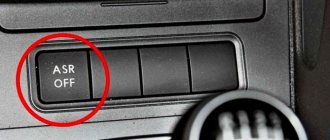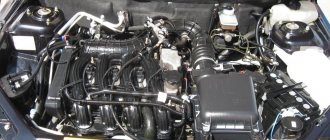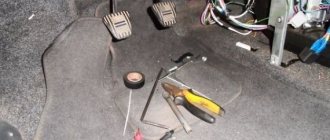If we consider the installation of an HBO system regarding the 3rd generation, then we can say that the requirements for implementation in a vehicle are reduced, and this is due to the fact that the environmental requirements of most cars do not rise above the Euro mark.
Of course, 3rd generation HBO is noticeably different from its predecessors, 1st and 2nd generations. The main difference is that the installation has parallel injection of the gas mixture. And car enthusiasts, before installing such a system in their car, should study the design features and find out how the installation of this system occurs. It is also necessary to understand why this generation has rapidly lost its demand in the market.
Installation and configuration of HBO
GBO installation is carried out by specialized workshops. They are certified, have trained specialists and the necessary equipment and tools for installation. These same workshops sell equipment of various configurations, repair and service it.
You can install the 1st generation kit on a carburetor or injection machine and connect it yourself, but it is better to contact specialists; installation and adjustment will not be expensive. But there will be all the documents necessary for registration, since this is making changes to the design of the car. Failure to note this in the documents will result in a fine of 500 rubles for the first violation. In addition, installers' warranties will come in handy.
The owner can make the settings himself. It is necessary to regulate the gas supply at every service, and when there are changes in engine operation, increased fuel consumption, etc. Adjustments are also required because over time the springs weaken, the membrane becomes dull, and the air filter becomes clogged.
All gas engines are very sensitive to air filter contamination. When it becomes clogged, the engine replenishes the missing volume of air with gas, significantly increasing consumption. Therefore, it is recommended to change it more often.
It’s easy to independently adjust the gas supply and stable operation of the engine with 1st generation gas equipment. Before you start adjusting the gas supply, you need to check and, if necessary, adjust the ignition. There are two adjustment screws on the gearbox. The idle speed screw and the sensitivity screw, and the quantity screw on the dispenser. Some manufacturers have a dispenser with two screws.
It is better to start setting up in the following order:
- Start and warm up the car engine.
- Unscrew the screw on the dispenser completely so as not to interfere with the flow of gas.
- Tighten the idle speed screw completely to prevent gas from leaking through the idle passage.
- The sensitivity screw located in the center of the gearbox at the end, loosen 4-5 turns.
Adjustment:
- Start the engine and tighten the sensitivity screw a quarter turn at a time. Do not hurry!
- It is necessary to take into account that the engine reaction will be slightly delayed, because gas remains in the hose and must be worked out. So, a quarter turn at a time, with pauses of 5-10 seconds, continue to tighten the screw until you feel that just a little more and the engine will stall.
- Now - the idle speed screw. We unscrew it a little at a time, smoothly, slowly, remembering the delayed reaction, until the engine speed rises to those recommended by the manufacturer. Usually this is 700-750 rpm. The engine should run smoothly and steadily without failures when over-throttled.
- Now the screw is on the dispenser, drivers nicknamed it the “greed tap.” Traction and consumption largely depend on it. Increase engine speed to 2000-2500 rpm. More is possible. While holding at these speeds, you need to tighten the screw. At a certain point, the engine will begin to lose speed, as if suffocating. There is no need to tighten it further; on the contrary, you need to unscrew the screw a quarter of a turn.
- Now we need to check the settings. Bring the engine to idle speed. If it works smoothly, steadily, and there are no failures when re-gasping, then the tuning was successful. If it is unstable at idle, level it using the idle speed screw. If failures remain, you need to configure again. There was an error somewhere.
For Solex equipment, the adjustments are slightly different. The difference is that there are two screws on the dispenser.
Installation of 3rd generation gas equipment
Installation of 3rd generation HBO on the injector is carried out similarly to the scheme of other systems. The sequence is as follows:
- place a gas cylinder with a multi-valve in the selected location;
- filling device;
- highways;
- gearbox;
- gas valve;
- dispenser;
- HBO button;
- ECU;
- nozzles are inserted;
- the wiring harness is laid and connected to the sensors.
It is also possible to install a 3rd generation LPG on a carburetor engine, but for its correct operation you will need to install a lambda regulation of the fuel mixture, a vacuum sensor, throttle position, crankshaft speed, and also a gasoline valve.
Such a solution would not be entirely appropriate. For cars with carburetor engines, it is still recommended to install simple and cheap gas equipment of the first or second type.
How to use: features of 4th generation HBO
Re-equipping a car for 4th generation gas is an opportunity to operate engines on gasoline and gas. You can switch fuel by pressing a button without leaving the car, either by manually adjusting the system or automatically.
The car's small control panel has an LED warning light indicating the gas level and a fuel switch. The panel can be located anywhere on the car panel where it is convenient for the driver to observe the signals.
What does the indicator show? If one of the four green LEDs is on, this means that the cylinder contains 10 liters of gas fuel. It will last for about 100-120 kilometers. The red LED indicates that there is very little gas left - about 50 kilometers away. This means that you need to refill the tank at the nearest gas station.
There is another red light located at the top of the panel. A flashing mode indicates that the car is running on gasoline and is preparing to switch to gas. This will happen every time you start the engine until the car warms up and the temperature reaches the desired scale mark.
The feature of duplicating gasoline and gas power systems significantly increases the level of reliability of the car engine. The vehicle's mileage increases with one filling of gasoline and gas. There are situations when HBO is very helpful, for example, on long trips, when there is a long distance between populated areas and there is no way to refuel.
Another feature of HBO: increased protection against car theft. If you remove the switch, and this is not difficult to do, then the supply of gas and gasoline to the injector will be blocked.
If the car has an expensive fuel injection system equipped with an exhaust purification catalyst, then the benefit will be double. Expensive AI-98 fuel is saved and the service life of the expensive device is increased.
Gas equipment is installed on cars that comply with Euro-3 and higher. The pulse supply system for gas-air mixtures is controlled by a separate control unit equipped with a microprocessor. By processing signals from the microprocessor, the unit sends pulses that open the nozzles for gas injection. The same principle is used to block the gasoline injectors.
The LPG sensor system determines the fuel concentration:
- gas pressure degree;
- gearbox temperature level;
- measures gas temperature.
When the gas pressure decreases, the electronic system turns off the gas injectors and starts the gasoline ones. The car engine starts running on gasoline.
Self-tuning
Before tuning, it is recommended to drive a little on gasoline, this is necessary so that the gasoline brains “feel” the normal mode and correct the correction factors.
All self-tuning can do is accurately determine the timing of gas injection at idle. All other engine modes require manual adjustment. It’s a pity, most often gas workers limit themselves to only this mode.
We connect the cable to the car, turn on the Lovato Easy Fast program, initialization occurs, which takes some time. In the lower right corner the cable icon is displayed with a green check mark. From this moment you can start setting up.
Let's start setting up:
- Go to the Self-Configuration menu.
- Close the gas screw of the gearbox completely and open it a few turns. The gas pressure should be within 1.2
-
1.4
bar (indicator in the program at the top). - Click the auto-tune button.
Self-tuning start button
Self-tuning in progress
During tuning, the engine may stall or stall altogether, which indicates an incorrect injector diameter.
After successful completion of auto-tuning, press the “Gasoline” button (upper right corner), the car switches to gas, compare the “Gas time” and “Gasoline time” indicators, these 2 times should be approximately the same, as a rule, gasoline time is less than gas time by 1- 2 ms. The closer these indicators are, the better the engine will perform at high loads and at idle. If the gas time is too high, it is necessary to drill out the injector jets or increase the gas pressure; if it is too low, then reduce the gas pressure.
Self-configuration completed correctly
When switching from gasoline to gas and back, the engine should run smoothly, this indicates correct self-adjustment of the idle speed.
Easy to maintain
The next important difference between the two latest versions of gas equipment is the almost complete absence of the need for any maintenance. As you know, the operation of version 4 requires regular cleaning and repair of the gearbox, maintenance and replacement of the gas injector, and frequent adjustment of the injection system
The new model does not have any of this: it only requires timely replacement of the pump filter.
An important difference between HBO 5 and HBO 4 is the use of the highest quality components in the latest model. Thus, instead of unreliable rubber tubes, which were present in large quantities in the 4th model of equipment, high-quality plastic tubes are used, which, even over long periods of operation, are not impregnated with odorants, without allowing gas to pass through their walls.
Thanks to this, in a vehicle running on the 5th generation, there will be no smell of gas in the cabin, as well as under the hood or even near the car itself: all connections of the system are as tight as possible.
In model 4, over time, even the rubber tubes begin to smell of gas, as a result of which an unpleasant odor can be felt both in the cabin and near the car. The new version completely eliminates this problem.
As you can see, progress does not stand still, I have a friend who installed the latest generation of LPG on his PRIORU - according to him, the installation has already paid for itself (he rode for about six months, although he drives a lot), then only the “gain” comes, the consumption is the same as About 8 liters of gasoline in the city, with manual transmission. As you can see, there is a lot to think about here.
Now let’s watch a visual video.
That's all, read our AUTOBLOG, it will be interesting.
Similar news
- Cost of gasoline. Let's look at the example of 1 liter in Russia and the United States...
- Odorants. What are they and why do natural gas need them?
- Gasoline additives. To increase octane number, clean injector...
Standard set of HBO 4th generation
4th generation gas equipment consists of:
- Gas cylinder. This is one of the main components of the equipment; you need to approach the choice of a cylinder carefully and with all responsibility.
- Highways (consumable and refueling). You can find out which highway to prefer from this article.
- Gearbox. This is a key element of the system; you need to choose a gearbox based on engine power and driving style, and give preference to well-known brands.
- A microcomputer is an electronic control unit for gas equipment, which is also often called “gas” brains.
- Gas injectors (according to the number of engine cylinders), which can be combined into a common rail. Injectors vary in operating speed, material and manufacturing design. The cheapest and relatively reliable option is Valtek rod gas injectors.
- Gas-petrol switch buttons.
- Gas filters (coarse and fine purification).
- Temperature sensors (measure coolant values).
- Three valves - inlet or filling, outlet or flow and emergency or high-speed;
An additional component of the 4th generation system is sometimes an ignition timing variator, which can extend the life of a gas engine, increase its power and reduce gas consumption.
Differences between first generation HBO
The search for an alternative to liquid fuel for cars has been going on for a long time. They began primarily in the West and had two main reasons - the high cost of fuel and air pollution from internal combustion engines. You shouldn’t think that the average person in Western countries is more concerned about the environment than we are. But the annual car tax there is directly tied to emissions, and demand for cleaner engines is stimulated financially.
As already mentioned, this search began a long time ago. At that time, most of the world's car fleet used carburetor engines, and more recently mass production of monoinjectors was launched. It was for these two types of engines that the 1st generation gas equipment was developed.
Since then, the automotive industry has come a long way. In most countries of Western Europe, environmental legislation was adopted, which made the use of such transport not only prohibited, but so expensive that it practically disappeared.
In the countries of Eastern Europe and the Asian region, environmental legislation is softer. This is primarily due to a lower standard of living, but we are interested in the fact that there are more than enough cars of this design in Russia. Accordingly, the first generation gas equipment is still in demand and is available for sale, although it is already installed quite rarely.
Features and applications
The first generation equipment is the simplest in design and the cheapest. The gas, in liquefied form in cylinders, is supplied to the reducer under its own pressure. The reducer reduces this pressure to the operating level.
In it, the gas changes from liquid to gaseous state. Subsequently, the fuel enters the fuel portion regulator, called the register. The gas is then directed to the carburetor or injector and subsequently burns in the engine, producing the necessary work.
Gearboxes in gas-cylinder equipment of this generation are of two types - electronic and vacuum. In the vacuum version, gas supply begins when the intake manifold creates a vacuum. In an electronic gearbox, this process is controlled by a twelve-volt coil.
The fuel mode switch has three positions. The third position is zero, when the supply of any fuel is blocked. Such equipment is installed on machines of outdated designs.
Conclusion
The third generation is considered outdated and is relevant only for a few cars. All these nuances should be carefully considered and discussed with a specialist. If the car owner decides to install this particular system, then the installation must be carried out only with the help of a competent car mechanic, who will be able to point out all possible faults and conduct a thorough diagnosis of all systems to prevent future breakdowns.
The rapid introduction and development of gasoline injection systems in internal combustion engines, new requirements and technologies have not left manufacturers and design engineers of gas equipment aside. It was decided to make some changes to the well-functioning HBO 2 system to ensure the possibility of “feedback” communication with the engine, entrusting part of the control to the electronic brain. This is how the 3rd generation HBO was born. Although, according to the European classification, this gas-cylinder equipment remains the second generation.
Differences and features of HBO 5
In gas equipment on 5th generation cars, the circuit was simplified, the number of elements was reduced and the process was automated.
Today, the most modern system used in Russia is the fifth version of gas cylinder equipment.
There are significant differences between 4th and 5th generation HBO. In the fifth family, the gearbox is eliminated, since it is no longer necessary to convert liquefied gas into vapor fuel.
An alternative to a reducer is a pressure regulator. He “makes sure” that the operating pressure (+5 bar from compression in the cylinder) is stable. This is necessary to prevent the gas from turning into steam under the influence of the heat generated by the motor.
The fifth generation allows propane to be delivered to the combustion chamber in the initial liquid phase. This is possible thanks to the pump that is built into the cylinder.
A pipeline is laid from it to the fuel rail (ramp). In parallel, there is a return line from the rail to the container. Along this path, unused gas is pumped into the cylinder.
A multivalve is responsible for pumping out remaining propane. The copper pipes familiar to previous versions are replaced with reinforced plastic ones.
In 4th generation equipment, it is necessary to cut the coolant pipes, and install tees at the break point, which can lead to a leak of antifreeze.
Let's look at how the 4th generation HBO differs from the 5th generation, except for the removal of the gearbox. A new product has been developed for family 5 - fast electromagnetic injectors. The injection pulse processing speed allows the injector to respond in 0.6 milliseconds. This is precisely the indicator that modern precision engines need for optimal performance.
For comparison: gas injectors in HBO 4 open in at least 2.5 ms. Reducing the injection time by almost five times makes it possible not to lose part of the power, as was the case in 4th generation units.
Another innovation in Euro-5 gas equipment is the connection of injectors to the standard rail. The characteristics of the injectors are identical to gasoline injectors. It is better to place them on the rack at a slightly different angle (on the side) so that the liquefied fuel does not heat up from the coil.
Such injectors are a step forward, because it is possible to use standard fuel maps. The gasoline controller makes adjustments to adapt the gas system to work with the car’s fuel map.
The fifth generation will not require frequent maintenance, like the 4th generation gas equipment: the gearbox is eliminated, as well as standard gas injectors that require periodic adjustments.
Flaws
The new equipment also has its disadvantages. System parts are very sensitive to dirty gas, so it is not always possible to repair a breakdown of such a structure.
Despite the small number of elements, the structure of HBO is complex. The disadvantages include the very large capital costs of installation.
Installation of 4th generation systems is cheaper, and operation and repair are simpler.
Jet selection
There is a misconception that the jets are located at the end of the hose and are installed in the manifold; in fact, the jets are installed directly into the gas injectors.
Where can I find Lovato LPG jets?
Make sure you have the correct jets selected. Here is a table of diameters, depending on the power of one cylinder.
| Power per cylinder, hp | Diameter, mm |
| 13-20 | 1,6 |
| 20-26 | 1,8 |
| 26-29 | 2,0 |
| 29-34 | 2,2 |
| 34-39 | 2,4 |
| 39-45 | 2,6 |
If necessary, drill out the jets.
Advantages and disadvantages
The 5th generation HBO has more advantages than the previous generation systems:
- The weak point of the 4th option is gas injectors, which quickly become coked due to the fact that the equipment is installed in the combustion chamber. In the newer system, a small amount of gasoline enters the injectors along with gas. Coking is excluded.
- To warm up the gearbox in the 4th generation, the system had to be connected to the stove. This involves interfering with the piping system where the cooling antifreeze is supplied. At the slightest depressurization, the equipment fails. The fifth generation does not provide a gearbox. There is no need to interfere with the cooling system.
- HBO 4th or 5th generation have differences in maintenance. The comparison is in favor of the latest version, where there is no need to take such mandatory preventive measures as repairing gas injectors and gearboxes. The mixture supply adjustment is completely computerized. Changing the filter at the same time as changing the oil is not difficult. Any debris fractions are retained by the pump and main filters.
- The engine output (e.g. turbocharged TFSI) remains the same as with gasoline. This indicator does not suffer at all, which cannot be said about all previous versions of HBO.
- The internal combustion engine of a car, which operates with the liquid phase of fuel, is in more gentle conditions than when supplying gas fuel in the vapor phase. This means that the engine’s overhaul life is extended.
- The car switches from standard fuel to liquid gas in a couple of minutes, regardless of whether it is cold or hot outside.
- The operation of the ramp with injectors in the fifth generation occurs in the same mode as on gasoline; the engine does not feel the difference.
- The quality of pipelines is an order of magnitude better in the fifth generation. They are more durable and can withstand higher pressures because they are made of reinforced plastic.
4th generation gas equipment also has advantages, for example, a more affordable price and components adapted to the low quality of gas. This applies to manufacturers such as Alpha, Lovato. Zavoli and Omvl are somewhat more expensive. As for Stag, there are budget and premium models.
Disadvantages of 5th generation gas equipment:
- More technologically advanced equipment is always more expensive. However, in this case this difference is quite significant. The fifth generation can cost two or three times more. This is one of the reasons why liquid gas supply to the engine has not yet become widespread.
- The high demands of 5th generation equipment on the quality characteristics of gas, due to which there is a possibility of failure of the gas pump and nozzle.
LPG with liquid gas injection differs in that it cannot operate on methane. Only propane-butane is used. This is a disadvantage, since methane fuel is more environmentally friendly and cheaper.
Before choosing gas equipment for your car, you need to carefully understand the difference between 4th and 5th generation LPG equipment, consider the advantages and disadvantages. And only then make the final decision on what equipment to purchase. If there is no access to high-quality gas, it is better to opt for the 4th generation. If a car has a complex fuel system with electronic filling, only high-tech fifth-generation gas equipment can be installed on it. You will have to look for a gas station that is trustworthy.
Read further:
Gas equipment 3rd generation: operating principle, installation, pros and cons
What is the operating principle of 6th generation HBO?
HBO 5th generation
LPG for direct injection: what is the difference, how to install?
HBO 2nd generation
Installation of equipment on a car
In order to adapt the engine for gas fuel and configure all equipment, you need to perform the following steps:
- Place the gearbox next to the engine and connect it to the cooling system. It should be parallel to the engine.
- Install the gasoline valve into the hose from the gasoline pump.
- The gas valve is installed on the engine shield. This is advisable from a safety point of view and for the ability to manually restore the gasoline supply in the event of gas valve malfunctions. But there are also built-in ones, directly into the gearbox.
- The mixer must be mounted under the engine. To avoid leaks, you must use a sealant, since the joining surfaces may be deformed.
- It is advisable to purchase a plastic pipeline, since, unlike copper, it bends easily.
- Gas cylinders are secured in the trunk shelf. To do this, drill 2 holes with a diameter of 10 mm. The fastening tape is laminated or has a rubber braid to avoid contact of the metal strips with the surface of the cylinders. The angle of inclination of the multivalve on the gas cylinder must be 30° to ensure correct gas supply to the system. To avoid explosion, cylinders should not be filled to more than 80% of their volume.
- The filling device can be located anywhere under the rear bumper.
- The fuel switch should be installed in the passenger compartment. Its installation diagram depends on the make and model of the machine.
Important: before connecting LPG to your car, you need to choose an installation method that is compatible with the specific type of car engine.
- How to turn on a BOSCH gas water heater?
What is HBO?
The system that allows a vehicle to run on gas is called LPG. Such installations can operate on propane (liquefied processed gas) and methane (natural vapor gas).
Blue fuel is better than gasoline in that it has a higher octane number (105 and higher). The ability to resist detonation is higher, so the spark plugs are not so exposed to soot, and the mixture coming out of the exhaust pipe is cleaner than after gasoline. The advantage of such systems is that you can switch to gasoline (diesel) at any time.
During the existence of gas structures for cars, separate generations of such systems have been formed. This happens in parallel with the improvement of the engines themselves.
What difficulties might there be?
The new installation of gas equipment is very demanding in terms of the quality of the gas mixture. This serves as a limiting factor in the spread of the fifth version of HBO in Russia and is practically the only drawback. Low quality gas has impurities that cannot be removed by filtration. For this reason, the gas pump may break down. And this is a very expensive “pleasure”, since it costs three quarters of the price of the HBO-5 kit.
You can extend the life of a gas pump by carrying out a number of preventive measures (cleaning and lubrication). There is hope that manufacturers will soon make the 5th generation gas pump more reliable and less demanding on gas quality.
For gas equipment of the 5th generation you need to pay 3 times more than for the 4th. Moreover, the more cylinders in the engine, the more injectors are needed. The price, accordingly, is even higher.
The new generation of gas-cylinder equipment is just beginning its march across Russia. There are still very, very few installation and adjustment specialists. Specialists are trained at European manufacturing plants to receive the appropriate certificates. There are not yet enough places for maintenance of this system.
It is not recommended to install and configure it yourself. It must be said that there are car manufacturers who make cars with LPG already installed.
The downside is that the 5th generation LPG does not work on methane due to the gaseous nature of methane. This is the meaning of the innovation of the new version of the equipment, the main difference of which is the supply of a liquid mixture rather than a gaseous one. And methane is always in a gaseous state. Maybe the time will come, and in the future manufacturers will combine two new technologies.
The more intensive the development of gas equipment, the more profitable its use and installation, the higher its rating. In any case, in the near future the newest system will conquer the gas equipment market in our country.
Read further:
Operating principle and difference between HBO generations 4 and 5
What is the operating principle of 6th generation HBO?
Everything you need to know about installing gas equipment on the Lada Largus
HBO 1st generation
Gas equipment 3rd generation: operating principle, installation, pros and cons
Generations of HBO
If you set a goal for yourself, then finding addresses and a suitable set of gas equipment that fits into your planned cost will not be difficult.
Just think about what kind of gas installation you want to see in your car. They can be divided into five generations, that is, 5 generations. This is what I still want to talk about.
Although there is now an active conversation regarding the 6th generation, which has received several design differences compared to its predecessor.
So I propose to briefly examine each option of gas equipment. This will allow you to understand which installation is best to install in your car. I would not recommend doing this yourself, relying on different videos.
First generation
This is a system equipped with vacuum control and a mechanical dispenser. They were installed only on carburetors. The design is extremely simple, so there were no problems with installation. And the repair is not difficult.
These are cheap, structurally elementary installations that can operate on motors that do not have feedback.
But such gas equipment does not at all comply with norms and standards. Therefore, installing such a system is the worst decision you can make.
Second generation
Here they began to use an electronic dispenser and the principle of operation on feedback. The oxygen sensor played an important role.
But LPG only complies with Euro 1 standards. The design is reliable and durable, significantly superior to the first generation.
Such devices quickly damage spark plugs and also cause constant popping noises while driving. An outdated version, to say the least.
Third generation
In many ways, a complete copy of the second generation, but with electronic dosage for fuel supply. Although there is also a similar system there, it has been significantly improved.
These gas pumps react slowly to attempts to gain speed, and the gas composition is poorly adjusted. Does it make sense to install equipment? No. Why? Yes, because it never reached the required Euro 3 standards.
Fourth generation
The third generation was a complete failure. Therefore, the engineers gained strength and did the fourth. Here you can clearly see how engineering is developing and modern technologies are being applied.
Many believe that in Eastern Europe there is nothing better than the 4th generation of HBO, despite the presence of 5th and 6th generations. Here they note the excellent implementation of control of the injectors, which are responsible for supplying fuel. Complies with Euro 3 standards.
Essentially, this is a copy of the injector, equipped with a nozzle on each cylinder. A risk that paid off.
Fifth generation
The next 5th generation LPG has reached Euro 4 standards. Suitable for cars with any injection engine and compatible with all sensors.
Gas is supplied in liquid form, electromagnetic types of injectors are used in the cylinders, the engine can operate on a cold start and the injector power is not lost, despite the transition from gasoline to gas.
Plus, the system makes it easy to return to gasoline.
Fine tuning(Online tuning)
After successful completion of self-tuning, you can proceed to the precise configuration of the fuel map.
Fuel correction:
Install the ODB adapter in the car's diagnostic socket, connect to it via Bluetooth from your phone using Torque (or a similar program). Display graph information about long-term and short-term correction. The essence of these parameters is to adjust the fuel. If any situation arises when the engine is supplied with a mixture that is too lean or too rich, then the opening time of the injectors is compensated by this coefficient. For example, clogged injectors will make the mixture leaner and the correction factor will increase. As a rule, this parameter cannot go beyond ± 25%. If a mixture problem persists for too long, the short-term correction is included in the long-term correction.
When setting up LPG, we will need to check the fuel correction coefficients for gasoline and gas and “press” the gas correction to the gasoline one in different operating modes.
Setting algorithm:
Setting up is best done with two people. Driver and adjuster. A more or less flat section of the road is selected, on which the same engine speed can be maintained for a long time.
Each cell in the fuel map corresponds to an injector opening time of 20 ms. Each injector is 8-bit, which means it has 256 time levels. 0-minimum value means that the injector is closed, 255 maximum value means that the injector is open full time.
It makes sense to make adjustments only in operating modes; say, if you do not “turn” the engine more than 4500, then there is no point in adjusting the map higher. The setting is carried out in stages, at each stage the engine speed increases by 500 rpm. The car moves for a long time at an adjustable speed.
Let's start setting up:
In the Lovato Easy Fast program, go to the “Configuration” section in the “Map” tab.
- Gasoline supply is turned on (using a button in the program)
- The driver sets a constant engine speed and precisely maintains it during tuning.
- At these revolutions, correction factors are read out via ODB.
- The gas is turned on (by button in the program)
- The correction factors are read again.
- The cell under the point on the fuel map is configured. If the correction factor is too large, the cell value is reduced, if small it is increased. I recommend selecting the entire column and changing it by several units at once. (After highlighting, press the Enter key.)
HBO lovato fuel correction map
After setup, the card is inspected for sudden changes in modes. A well-tuned map is smooth, i.e. neighboring cells do not differ much in value. If there are uneven lunges, I recommend manually “straightening” the area around them.
If everything is configured correctly, you will get minimal gas consumption and maximum thrust.











